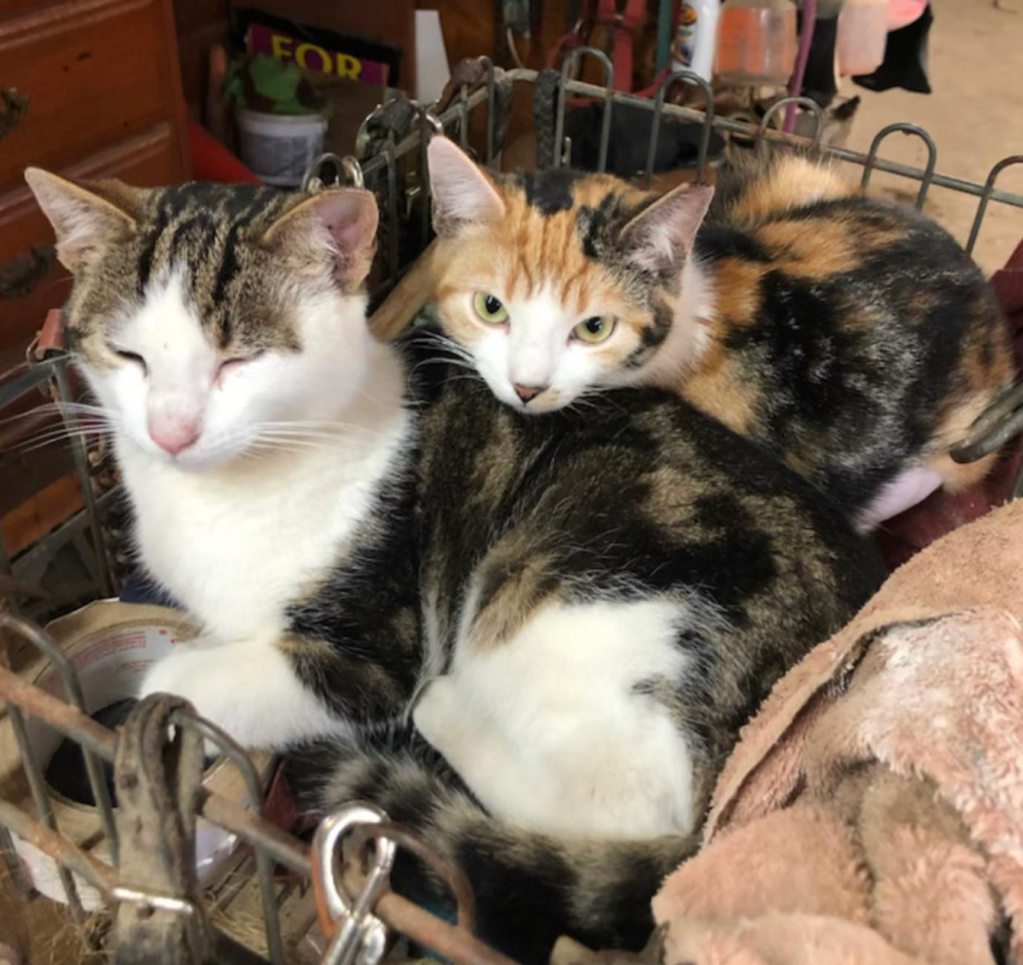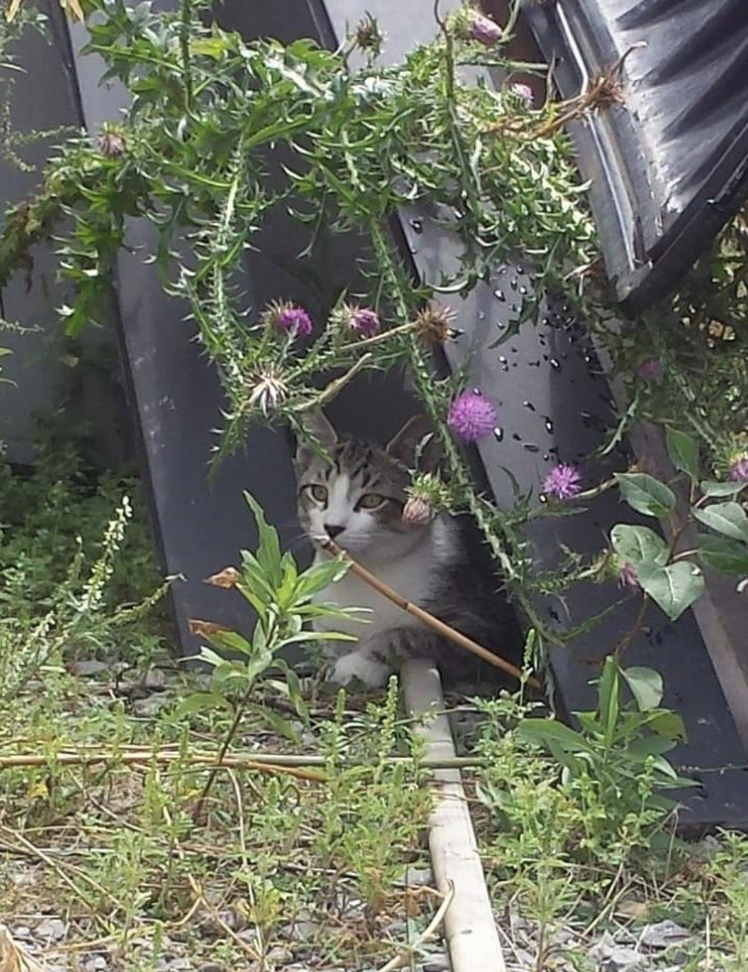
MEDIA
IN THE NEWS
Podcasts

Logo by Kim Russell
‘Operation Catnip helps feral cats and you can too‘
Peterborough Currents, November 30, 2018
Thank you to Ayesha Barmania for featuring Operation Catnip!
Podcast Transcript
Ayesha:
If you drive north of downtown Peterborough for about 30 kilometers, you end up in beautiful cottage country. The land around you shifts from fertile farmland to gorgeous lakes and the beginnings of Northern Ontario rocky outcrops start to appear.
After about a half hour of driving, you pass through the village of Burleigh Falls. You’ll notice a roadside inn, a gas station, a restaurant, a boat launch. And if you stop at this little village, and walk around the outside of the inn, and keep a watchful eye, you might spot the darting tails of dozens and dozens of feral cats.
Creeping around the decks of cottages, and by the foundation of the inn, there’s a fairly enormous feral cat colony. Most of these cats were born last fall, and they made it through last winter with the help of a small group of Colony Caregivers, including residents of Burleigh Falls, and a couple who decided they just needed to help.
Brienne:
Hi, my name is Brienne, and I am one of the people that started to notice this colony and decided that they needed help.
Adam:
And my name is Adam Rowland, and I’m Brienne’s fiancé, and together we’ve sort of started an initiative where we’re trying to care for the Burleigh Falls colony of cats.
Ayesha:
Brienne and Adam made the drive from Peterborough to Burleigh Falls every week to deliver food. They, with the help of other volunteers, basically built a cat apartment complex out of bins and blankets. And all the while, they were trying to trap and neuter these kittens. When I visited them in the spring, there were just a couple of elusive cats that wouldn’t come close. The whole effort started when they saw a little kitten freezing in the cold.
Adam:
Yeah, so when we first came up, we would just feed the cats whenever, we would bring our leftovers, but at one point we noticed last September, there were some kittens that were born, and there had been a lot of kittens born throughout the summer. But unfortunately, we learned after a really cold night once that those kittens had died. And for us, that was the really the point where we decide, okay, we’ve got to do something to prevent more of these kittens to be born and the weather is just not going to be hospitable for them. And the colony had grown really that summer from about three the year before, to on this side about 26. So, it was a huge growth. And we thought there’s a lot of young cats that aren’t going to be equipped for a really cold winter here. So that’s when we jumped into action.
Ayesha:
They jumped into action. And as of this September, Brienne and Adam announced that they had trapped and neutered every one of the nearly 50 feral cats. And they’re able to do so with the support of local organization Operation Catnip. And to find out more about what they do, I spoke with Monique Beneteau, a volunteer with Operation Catnip, about what the group does.
Monique:
I’m Monique Beneteau, I am a volunteer like everyone else with Operation Catnip. Yeah, the group started, it was the wish and hope of one person who brought together a group of people who met in February of 2012. And it took about a year to kind of figure out just what exactly we were going to land on, in terms of where we were putting our energies, and the TNR was where we landed. So yeah, 2013 is when we started.
Ayesha:
Who was that one person?
Monique:
Margaret Bonigut, she was the owner of Maggie’s Eatery and a serious cat lover, and was taking care of some feral cats in her neighbourhood. And just felt like, you know, something needed to happen. And so she brought, she just called a community meeting, 25 people came out. It was a storm on February 28th and so we worked from there, in a nutshell.
Operation Catnip is a Trap-Neuter-Release program. We trap feral, also abandoned or stray cats, so cats who don’t have any owners, who are out in the community, and we will trap them, take them to vets, have them spayed and neutered, and then we return them back to where we found them. And so we work with colony caregivers, so we don’t just go around picking up stray cats. We have people who contact us, who have agreed to care for those animals, provide them with food and shelter. We ask them if they can, to also pay for the expense, some of the expenses, not the whole thing, and to also make a commitment to care for those animals once they get returned.
Ayesha:
And so you work with these colony caregivers. What is the role that Operation Catnip takes on from there? Is that just the trapping?
Monique:
Yeah, so when a caregiver contacts us, it’s quite a process, the trappers, usually they work in pairs, we’ll go and visit the caregiver, get a sense of how many cats there are, what the situation is, what commitment the caregiver can give us. And then they’ll develop a strategy for doing the trapping. If the caregiver hasn’t been feeding regularly and the cats aren’t coming regularly, we encourage them to start putting them on a regular feeding schedule, so that it makes trapping easier so that when we’re ready to do the trapping, you withhold food the night before, our trappers come with the trap, they’ll set it up, put some really smelly, enticing food for them.
And hopefully, if all works well, they just trot into the trap. And then we take them to a pre-op environment. It depends, sometimes we’ve had volunteers who have had space where we can actually keep the cats there. Sometimes we ask the caregivers to do that pre-op care, which just means that they’re holding the cat in that trap until we can get a vet appointment. We have one of our volunteers whose primary responsibility is to call our participating vets to see who has space available to do the surgery. We transport the cats to the clinics, they do their thing there, so in addition to actually doing the surgery, they check them out, make sure they’re healthy, give them some vaccinations. Oftentimes, there are some wounds or injuries that might require some antibiotics, that kind of thing. And then once the surgeries are done, we pick them up again. If we have a post-op site, we will bring them there, we keep them for 24 hours, and then bring them back to the caregiver, or to the colony site, and we release them there.
Ayesha:
I know last year there was that cats on leashes bylaw that was put in place, in an effort to kind of curb bird deaths, I think was part of it as well. Do these feral cats that you’ve returned contribute to bird deaths at all?
Monique:
Yeah, I mean, I would be naive to say that they don’t. We know that’s just something, a natural instinct that cats do. And I’m a bird lover too, I love all animals. I understand the concerns that our bird lovers have around the contribution that cats make to the deaths of birds. I would argue though, that humans have probably been more responsible for bird deaths in terms of loss of habitat and glass buildings and all kinds of things. I do know from personal experience; my neighbour and I have cared for a couple of feral cats over the last few years. Once they get spayed and neutered, especially the males, they don’t roam as much. They probably do some hunting, but because they’ve got a regular food source, I don’t see that happening as much. I had a neighbour’s cat who I witnessed more frequently killing chipmunks and birds than the feral cats did.
And so the bylaw, I think that there is some value, I do. People get really passionate about these issues. I’m a cat owner, I do believe cats should be indoors. I really think that it’s in their best interests, health-wise for their health, but also the health of other living beings in the environment that they stay indoors. And so, I’m okay with that bylaw, but you know, I am not going to fault feral cats because they’re outside and they’ve become wild, because humans let them out. Any cat who is outside was once a domestic cat, or is a descendant of a domestic cat. And they’re feral now because we’ve abandoned them.
Ayesha:
Yeah. And then just kind of lastly, how did you get involved? What’s your interest in cats and caring for feral cats?
Monique:
Honestly, I’m not sure what happened! I mean, like I said, I’m an animal lover. I’ve always been concerned about animal welfare. And this seemed to be an issue, an area that nobody was talking about. We have great shelters, they get a lot of support in our community, they could use more support. And it’s probably because Henry, our feral cat, started hanging out in our backyard, and I didn’t know what to do. There were no resources when he showed up, and so I was already caring for a feral cat when we found out about this, and I thought you know what, I can get behind this.
Ayesha:
That’s wonderful. Well, thanks so much for telling us.
Monique:
Thank you for inviting us.
Ayesha:
That was Monique Beneteau speaking about Operation Catnip. Since they were founded in 2013, they have helped trap, neuter, and release over 800 cats, many of which were adopted into loving homes. And as someone with two formerly feral cats as pets, I would encourage you to take a chance on them. You do have to put a lot of time and effort into building trust, but my cats are the nicest and weirdest cats. And so, as the seasons change, and the weather gets more and more snowy, and you see a feral, abandoned, or stray cat in your neighbourhood, consider what you can do to help. We’ve made a little guide for our website about how you can make an outdoor cat shelter, and if you want to take the next step, you can get in touch with Operation Catnip to learn more about how you can trap, neuter, and release, or adopt, these furry little friends.
Video
McDougall Fund Submission Video
(2020)
Global/Chex News
(2021)
Articles & Mentions

“In a perfect world we wouldn’t need to exist. If everyone got their cats spayed and neutered, if people cared more for animals, we wouldn’t need to be here.”
Working together to reduce animal overpopulation in Curve Lake First Nation – Ontario SPCA and Humane Society, January 14th, 2022.
Operation Catnip Peterborough is on a Mission to Spay and Neuter All Feral Cats in the City – PTBO Canada, November 5th, 2021.
Operation Catnip hosting workshop to teach people to trap, neuter and release the homeless cats of Peterborough – Jason Bain, Peterborough Examiner, September 8th, 2017.
Letter to the Editor: Operation Catnip really helps and here’s how – Linda Steele, Peterborough Examiner, November 24th, 2016.
Operation Catnip looking to deal with Peterborough’s feral cat problem – Peterborough Examiner, February 15th, 2013.
ALUMNI GALLERY





























































































